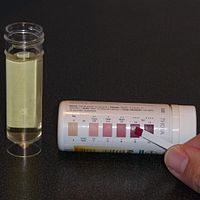
Photo from wikipedia
OBJECTIVES This retrospective analysis sought to: (1) characterize a cardiovascular risk-reduction clinic (CVRRC) patient population with serious mental illness (SMI); (2) analyze clinical outcomes of CVRRC patients over a 2-year… Click to show full abstract
OBJECTIVES This retrospective analysis sought to: (1) characterize a cardiovascular risk-reduction clinic (CVRRC) patient population with serious mental illness (SMI); (2) analyze clinical outcomes of CVRRC patients over a 2-year period; and (3) compare outcomes for individuals prescribed different antipsychotic treatments in the CVRRC patient population over a 2-year period. EVALUATION METHODS In 2016, A pharmacist-managed CVRRC was implemented within a primary care clinic for patients with SMI. The CVRRC operates under a collaborative practice agreement allowing the pharmacist to initiate and change medications and order laboratory tests. Baseline data collected included demographic information, referring provider, tobacco use, and 10-year atherosclerotic cardiovascular disease risk. Data collected at subsequent visits included date of visit, A1C, estimated average glucose (eAG), blood pressure, weight, body mass index, low-density lipoprotein cholesterol, non-high-density lipoprotein cholesterol, statin and dose, tobacco use, amount smoked, and current antipsychotic treatment. Number of times that treatment for diabetes was initiated or intensified by the pharmacist or primary care provider was also collected. IMPACT OF INNOVATION A total of 101 patients were referred to the CVRRC over the 2-year period. Of these, 81 (80.2%) had at least 1 subsequent visit and were included in the A1C analysis. CVRRC patients had a statistically significant improvement in A1C over time. Mean A1C decreased by an increment of 0.06% for each month increase in follow-up time (P < 0.0001). There was no significant difference in A1C values between patients on different antipsychotic treatments (P = 0.74). CONCLUSION The pharmacist-managed CVRRC demonstrated beneficial outcomes for individuals diagnosed with diabetes and SMI. Results provide promising evidence supporting future larger studies to confirm these findings. Considering the morbidity and mortality disparities for individuals with SMI, health care organizations should consider similar models to improve diabetes outcomes.
Journal Title: Journal of the American Pharmacists Association : JAPhA
Year Published: 2019
Link to full text (if available)
Share on Social Media: Sign Up to like & get
recommendations!